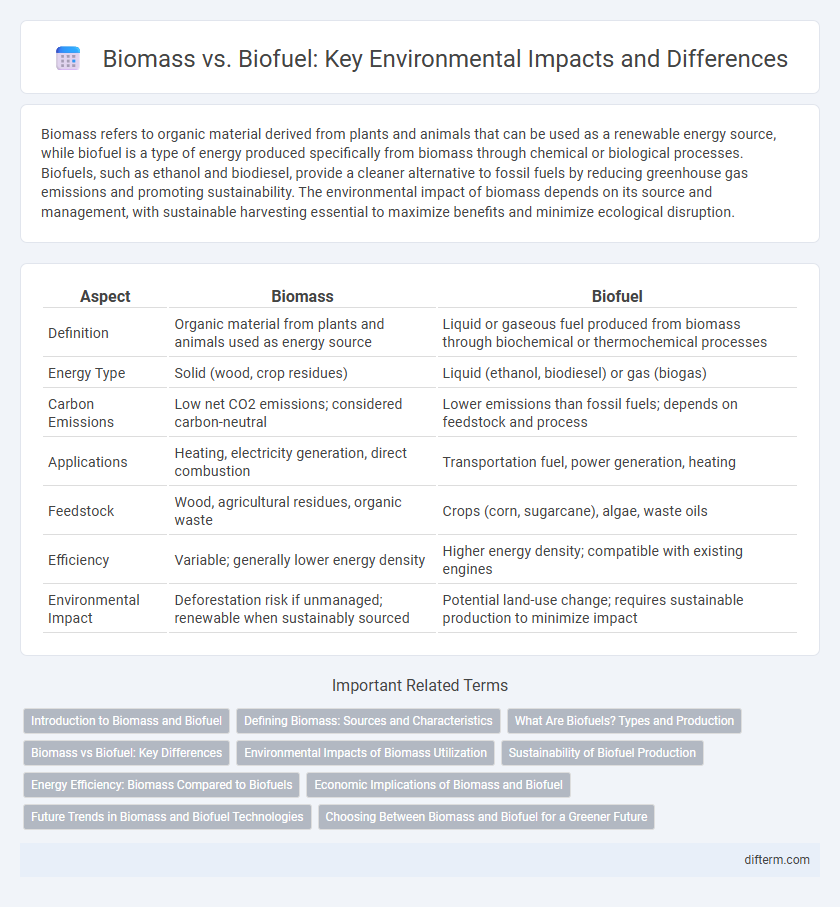Biomass refers to organic material derived from plants and animals that can be used as a renewable energy source, while biofuel is a type of energy produced specifically from biomass through chemical or biological processes. Biofuels, such as ethanol and biodiesel, provide a cleaner alternative to fossil fuels by reducing greenhouse gas emissions and promoting sustainability. The environmental impact of biomass depends on its source and management, with sustainable harvesting essential to maximize benefits and minimize ecological disruption.
Table of Comparison
| Aspect | Biomass | Biofuel |
|---|---|---|
| Definition | Organic material from plants and animals used as energy source | Liquid or gaseous fuel produced from biomass through biochemical or thermochemical processes |
| Energy Type | Solid (wood, crop residues) | Liquid (ethanol, biodiesel) or gas (biogas) |
| Carbon Emissions | Low net CO2 emissions; considered carbon-neutral | Lower emissions than fossil fuels; depends on feedstock and process |
| Applications | Heating, electricity generation, direct combustion | Transportation fuel, power generation, heating |
| Feedstock | Wood, agricultural residues, organic waste | Crops (corn, sugarcane), algae, waste oils |
| Efficiency | Variable; generally lower energy density | Higher energy density; compatible with existing engines |
| Environmental Impact | Deforestation risk if unmanaged; renewable when sustainably sourced | Potential land-use change; requires sustainable production to minimize impact |
Introduction to Biomass and Biofuel
Biomass refers to organic materials such as plant residues, wood, and agricultural waste used as renewable energy sources. Biofuels are liquid or gaseous fuels derived from biomass through biochemical or thermochemical processes, including ethanol, biodiesel, and biogas. Both biomass and biofuels contribute to reducing greenhouse gas emissions by substituting fossil fuels with sustainable alternatives.
Defining Biomass: Sources and Characteristics
Biomass refers to organic material derived from plants, animals, and microorganisms that serves as a renewable energy source. Common sources include agricultural residues, forestry by-products, and dedicated energy crops characterized by high carbon content and energy density. These materials undergo processes such as combustion, anaerobic digestion, or gasification to generate heat, electricity, or biofuels, highlighting their versatility in sustainable energy production.
What Are Biofuels? Types and Production
Biofuels are renewable energy sources derived from organic materials such as plants, algae, and waste, designed to reduce reliance on fossil fuels and lower greenhouse gas emissions. The main types of biofuels include first-generation biofuels made from food crops like corn and sugarcane, second-generation biofuels produced from non-food biomass such as agricultural residues and woody crops, and third-generation biofuels derived from algae. Production methods vary by type but generally involve processes like fermentation, transesterification, and pyrolysis to convert biomass into liquid fuels like ethanol, biodiesel, and biogasoline.
Biomass vs Biofuel: Key Differences
Biomass refers to organic materials like wood, agricultural residues, and animal waste used as raw resources, while biofuel is a liquid or gaseous fuel derived from biomass through processes such as fermentation or anaerobic digestion. Biomass is primarily utilized for direct energy production, such as heating and electricity generation, whereas biofuels serve as renewable substitutes for conventional fuels in transportation and industrial applications. The conversion efficiency, energy density, and emission profiles significantly differ between biomass and biofuels, influencing their respective environmental impacts and usage.
Environmental Impacts of Biomass Utilization
Biomass utilization significantly reduces greenhouse gas emissions by capturing carbon dioxide during plant growth, making it a renewable energy source with a lower carbon footprint compared to fossil fuels. However, large-scale biomass harvesting can lead to deforestation, loss of biodiversity, and soil degradation, impacting ecosystems negatively. Sustainable management practices and technological advancements in biomass conversion are essential to mitigate these environmental challenges and maximize the ecological benefits.
Sustainability of Biofuel Production
Biofuel production from biomass leverages renewable organic materials, reducing reliance on fossil fuels and lowering greenhouse gas emissions. Sustainable practices in biofuel production prioritize efficient land use, minimal water consumption, and preservation of biodiversity to mitigate environmental impacts. Advances in second-generation biofuels, derived from non-food biomass like agricultural residues and forest waste, enhance sustainability by avoiding competition with food crops and promoting circular economy principles.
Energy Efficiency: Biomass Compared to Biofuels
Biomass energy conversion typically exhibits higher overall energy efficiency due to the direct combustion or anaerobic digestion processes, which minimize energy loss compared to the multi-step refining required for biofuels. Biofuels often involve intensive biochemical or thermochemical conversion stages that reduce net energy gain despite their higher energy density. Evaluating energy return on investment (EROI) reveals biomass systems generally deliver more sustainable energy output per input, enhancing renewable energy portfolios in environmental management.
Economic Implications of Biomass and Biofuel
Biomass energy offers significant economic benefits by utilizing agricultural residues and waste, reducing reliance on imported fuels and creating rural employment opportunities. Biofuels, derived from biomass through advanced processing, provide a renewable alternative to fossil fuels, contributing to energy security and price stability in volatile markets. Investment in biofuel infrastructure stimulates technological innovation and can drive economic growth in regions rich in biomass resources.
Future Trends in Biomass and Biofuel Technologies
Emerging trends in biomass and biofuel technologies highlight increasing efficiency in feedstock conversion processes, such as advanced enzymatic hydrolysis and gasification techniques. Research emphasizes second and third-generation biofuels derived from non-food crops and algae to address sustainability and reduce carbon emissions. Integration of artificial intelligence and machine learning optimizes biomass supply chains and bio-refining operations, accelerating the transition to a low-carbon economy.
Choosing Between Biomass and Biofuel for a Greener Future
Biomass and biofuel both offer renewable energy solutions that reduce greenhouse gas emissions compared to fossil fuels, but they differ in production and application. Biomass encompasses organic materials like wood and agricultural residues used directly for heat or electricity, while biofuels such as ethanol and biodiesel are liquid fuels derived from biomass for transportation. Prioritizing biofuels can enhance energy security and lower carbon footprints in transport sectors, whereas biomass supports decentralized energy generation and waste reduction.
biomass vs biofuel Infographic

 difterm.com
difterm.com